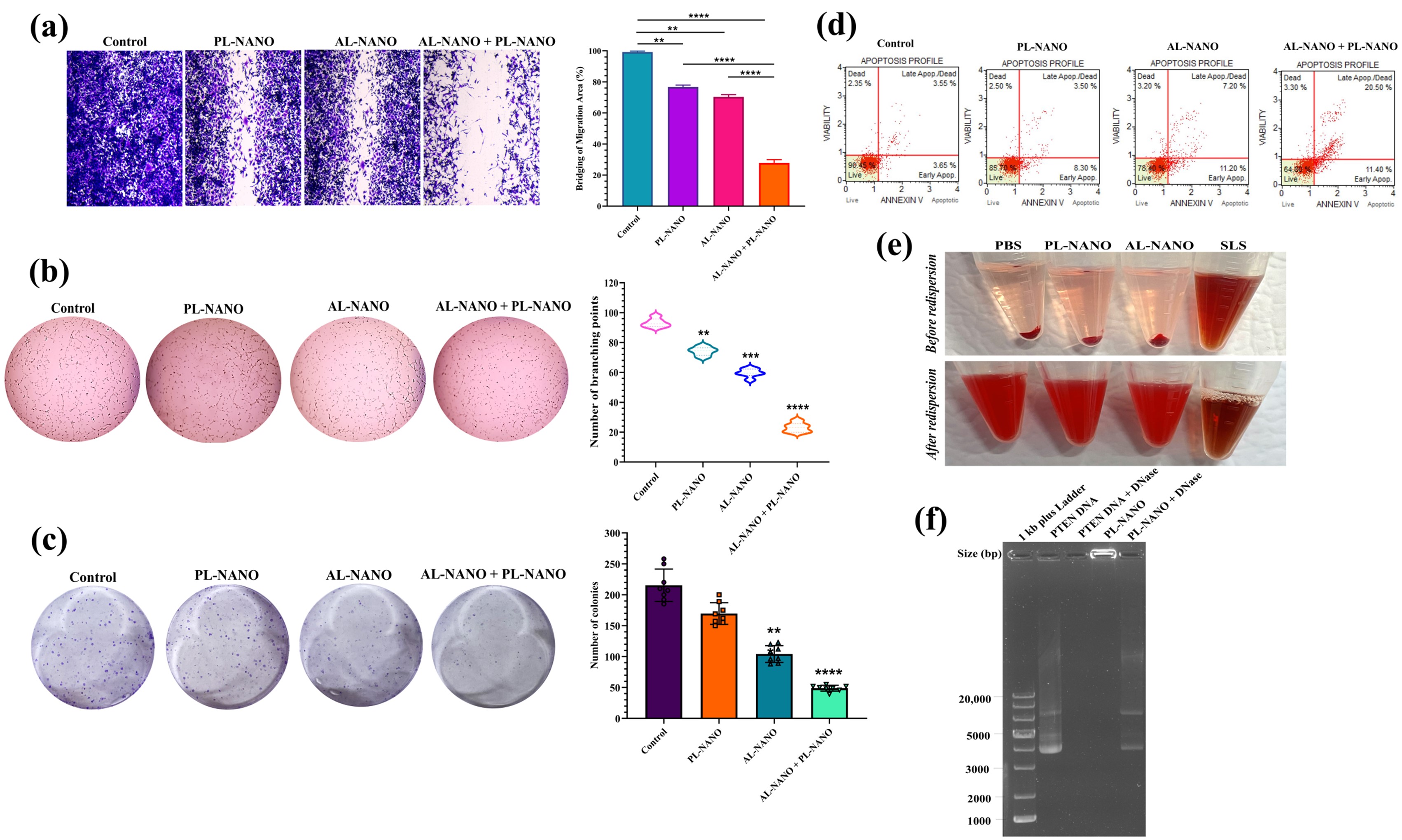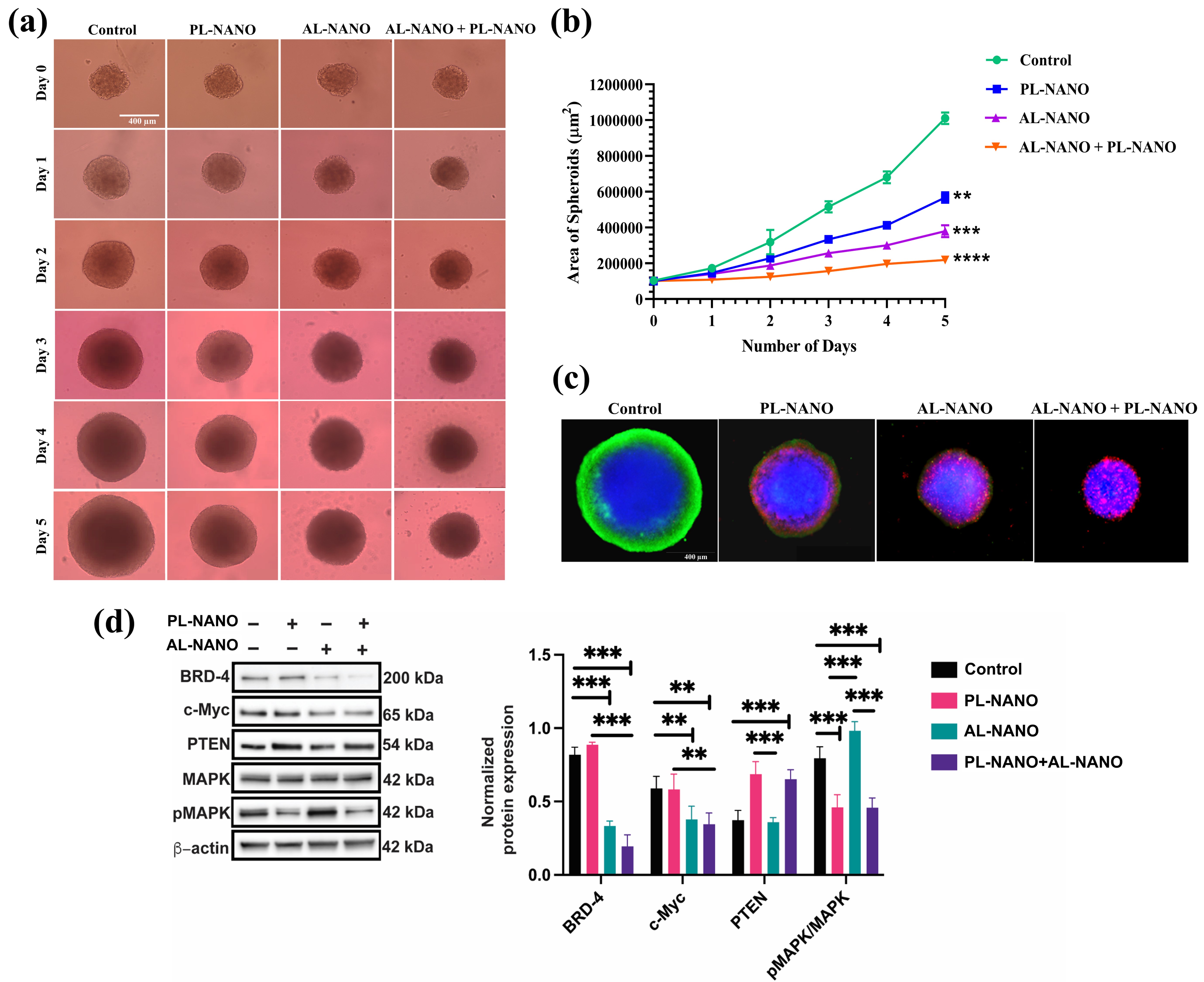Formulation and Delivery - Biomolecular
Category: Poster Abstract
(T1230-11-74) Novel Gene Therapy for Drug-Resistant Melanoma: Synergistic Combination of PTEN Plasmid and BRD4 PROTAC Loaded Lipid Nanocarriers
Tuesday, October 24, 2023
12:30 PM - 1:30 PM ET

Aishwarya Saraswat, PhD (she/her/hers)
Senior Scientist
Regeneron Pharmaceuticals, Inc.
Tarrytown, New York, United States- AS
Aishwarya Saraswat, Ph.D.
St. John's University
jamaica, New York, United States - HV
Hari Priya Vemana, Ph.D. (she/her/hers)
St. John's University
JAMAICA, New York, United States - KP
Ketan Patel, Ph.D.
St. John's University
Jamaica, New York, United States
Presenting Author(s)
Main Author(s)
Co-Author(s)
Purpose: Given that BRAF mutations occur in more than 50% of melanoma cases, a potent BRAF inhibitor (BRAFi) like vemurafenib (VEM) evolved as targeted therapy for BRAFV600E mutant melanoma. However, patients have tumor recurrence merely within 7 months of treatment with VEM resulting in highly aggressive drug-resistant melanoma. This stances a major clinical problem and it has been proven that diverse molecular pathways driving BRAFi resistance finally converge to activation of c-Myc oncogene in melanoma. Therefore, we identified a novel combinatorial therapeutic strategy by targeting loss of PTEN tumor suppressor gene and upregulated BRD4 oncoprotein as Myc-dependent vulnerabilities of drug-resistant melanoma. Being promising therapeutic targets, we decided to concomitantly deliver PTEN plasmid and BRD4 targeted PROteolysis-TArgeting Chimera (ARV) to drug the “undruggable” c-Myc oncogene in BRAFi-resistant melanoma (Fig. 1a). Since PTEN plasmid and ARV are distinct in terms of their physicochemical properties, we fabricated PTEN plasmid and ARV loaded lipid nanocarriers for their simultaneous delivery to cooperatively inhibit BRAFi-resistant melanoma progression. Objectives of our research were to; (a) develop and characterize PTEN plasmid (PL-NANO) and ARV (AL-NANO) loaded lipid nanocarriers and (b) evaluate synergism in anticancer activity of PL-NANO and AL-NANO in various 2D and 3D BRAFi-resistant melanoma models.
Methods: PL-NANO composed of an FDA approved ionizable lipid, DOPC, DOPE, cholesterol and DSPE-PEG2000 were fabricated using staggered herringbone micromixer at flow rate ratio of 4:1 (aqueous: organic) and total flow rate of 5 mL/min. To incorporate a bulky PROTAC molecule like ARV, modified hydration method was employed using DOPC, cholesterol and DSPE-PEG2000 resulting in formation of AL-NANO containing ARV concentration of 1 mg/mL. Both PL-NANO and AL-NANO were optimized followed by their physicochemical characterization and morphology analysis using cryo-TEM. Synergism in anti-proliferative effect of nanoformulations were evaluated in developed BRAFi-resistant (A375R, SK-MEL-28R, RPMI-7951) melanoma cell lines using in vitro assays including MTT, migration, clonogenic assay, vasculogenic mimicry and apoptosis analysis by flow cytometry. To better mimic the in vivo tumor microenvironment, we analyzed the growth and apoptosis of A375R 3D spheroids following PL-NANO and AL-NANO treatment. Nuclease protection, serum stability, and hemolysis assays were preformed to identify systemic safety of PL-NANO and AL-NANO formulations. Western blot was carried out to confirm expression of target proteins PTEN, BRD4, MAPK, p-MAPK and c-Myc in A375R cells.
Results: AL-NANO prepared by modified hydration method exhibited uniform particle size of 90.3 ± 10.1 nm, PDI of 0.203, neutral surface charge and >99% entrapment efficiency of ARV as analyzed by HPLC (Fig. 1b). Microfluidic mixing resulted in particle size of 85.8 ± 6.4 nm, PDI of 0.103, neutral surface charge and >99% entrapment efficiency of PTEN plasmid as determined by PicoGreen assay for PL-NANO (Fig. 1c). Agarose gel electrophoresis results showed complete entrapment of PTEN plasmid with no DNA migration bands observed for PL-NANO (Fig. 1d). Combination treatment resulted in significantly enhanced cytotoxicity of AL-NANO in both acquired (A375R) and intrinsic (RPMI-7951) BRAFi-resistant melanoma cells (Fig. 1e). An IC50 of as low as 20 nM was achieved in A375R cells and 8 nM was obtained in RPMI-7951 cells for AL-NANO when transfected with higher dose (1 µg) of PL-NANO (Fig. 1f). Simultaneous delivery of both nanoformulations revealed significant inhibition in in vitro migration, colony forming ability, and vasculogenic mimicry while inducing significant apoptosis of A375R cells as compared to individual treatment or control groups (Fig. 2a-d). Both formulations exhibited negligible hemolysis when tested in mice RBCs (Fig. 2e). Agarose gel electrophoresis results showed bright migration bands obtained for PTEN plasmid extracted from PL-NANO indicating that it was well-protected against enzymatic degradation (Fig. 2f). More importantly, we observed that PL-NANO and AL-NANO combination led to the highest reduction in the area of A375R 3D spheroids compared to individual treatment groups while the control showed exponential growth (Fig. 3a-b). Notably, combination of both nanoformulations showed a substantially higher apoptotic population as depicted by bright red fluorescence in A375R 3D spheroids (Fig. 3c). Significantly higher expression level of PTEN protein attained by western blot analysis indicated successful delivery of PTEN plasmid following transfection with PL-NANO alone and in combination in A375R cells. Moreover, substantially reduced levels of BRD4, c-Myc and pMAPK/MAPK proteins was observed following simultaneous delivery of PL-NANO and AL-NANO in A375R cells (Fig. 3d). Hence, western blot analysis results confirmed attainment of PTEN upregulation and BRD4 degradation to finally achieve suppression of c-Myc oncogene by simultaneous delivery of PL-NANO and AL-NANO in BRAFi-resistant melanoma. Combinatorial delivery of both the lipid nanoformulations would be further tested for their anticancer efficacy and tumor distribution in BRAFi-resistant melanoma xenograft model.
Conclusion: Our study demonstrated the robust anticancer efficacy of PL-NANO and AL-NANO combination against drug-resistant melanoma. Therefore, lipid nanocarriers delivering lethal cocktail of PTEN tumor suppressor gene and BRD4 oncoprotein degrader is a “one-of-a-kind” gene therapy to target “undruggable” c-Myc oncogene in BRAFi-resistant melanoma.
 Fig. 1. (a) Graphical representation of a novel gene therapy approach for BRAFi-resistant melanoma targeting downregulation of BRD4 oncoprotein via ARV-loaded liposomes (AL-NANO) and upregulation of PTEN tumor suppressor via PTEN plasmid-loaded lipid nanoparticles (PL-NANO) for their simultaneous delivery. (b) Dynamic light scattering graph and cryo-TEM image illustrating unimodal particle size distribution of AL-NANO. (c) Dynamic light scattering graph and cryo-TEM image illustrating unimodal particle size distribution of PL-NANO and representative agarose gel electrophoresis image illustrating binding efficiency and complete entrapment of PTEN plasmid within PL-NANO. (d) MTT cytotoxicity curves in A375R and RPMI-7951 cell lines indicating strong synergism between AL-NANO and PL-NANO in acquired and intrinsically BRAFi-resistant melanoma cell lines. (e) IC50 values of ARV in AL-NANO alone and in combination with PL-NANO in BRAFi-resistant melanoma cell lines illustrating synergistic anticancer activity.
Fig. 1. (a) Graphical representation of a novel gene therapy approach for BRAFi-resistant melanoma targeting downregulation of BRD4 oncoprotein via ARV-loaded liposomes (AL-NANO) and upregulation of PTEN tumor suppressor via PTEN plasmid-loaded lipid nanoparticles (PL-NANO) for their simultaneous delivery. (b) Dynamic light scattering graph and cryo-TEM image illustrating unimodal particle size distribution of AL-NANO. (c) Dynamic light scattering graph and cryo-TEM image illustrating unimodal particle size distribution of PL-NANO and representative agarose gel electrophoresis image illustrating binding efficiency and complete entrapment of PTEN plasmid within PL-NANO. (d) MTT cytotoxicity curves in A375R and RPMI-7951 cell lines indicating strong synergism between AL-NANO and PL-NANO in acquired and intrinsically BRAFi-resistant melanoma cell lines. (e) IC50 values of ARV in AL-NANO alone and in combination with PL-NANO in BRAFi-resistant melanoma cell lines illustrating synergistic anticancer activity. Fig. 2. (a) Microscopic images of scratch assay and percentage inhibition of migration produced by PL-NANO, AL-NANO, and PL-NANO + AL-NANO as compared to control in A375R cells. (b) Vasculogenic mimicry images and quantitative analysis of number of branching points formed in each treatment group as compared to control in A375R cells. (c) Representative images and quantitative illustration of percentage decrease in the number of colonies formed with individual and combination treatment as compared to control in A375R cells. (d) Flow cytometry analysis results depicting significant apoptotic effect of PL-NANO and AL-NANO combination resulting in 31.9% apoptotic cell population in A375R cells. (e) Negligible hemolysis demonstrated by PL-NANO and AL-NANO as tested in mice RBCs. (f) DNase protection assay results illustrating prevention of PTEN-DNA from enzymatic degradation by PL-NANO using agarose gel electrophoresis. **p < 0.01, ***p < 0.001, ****p < 0.0001.
Fig. 2. (a) Microscopic images of scratch assay and percentage inhibition of migration produced by PL-NANO, AL-NANO, and PL-NANO + AL-NANO as compared to control in A375R cells. (b) Vasculogenic mimicry images and quantitative analysis of number of branching points formed in each treatment group as compared to control in A375R cells. (c) Representative images and quantitative illustration of percentage decrease in the number of colonies formed with individual and combination treatment as compared to control in A375R cells. (d) Flow cytometry analysis results depicting significant apoptotic effect of PL-NANO and AL-NANO combination resulting in 31.9% apoptotic cell population in A375R cells. (e) Negligible hemolysis demonstrated by PL-NANO and AL-NANO as tested in mice RBCs. (f) DNase protection assay results illustrating prevention of PTEN-DNA from enzymatic degradation by PL-NANO using agarose gel electrophoresis. **p < 0.01, ***p < 0.001, ****p < 0.0001. Fig. 3. (a) Representative bright field images of A375R 3D spheroids treated with PL-NANO, AL-NANO, and PL-NANO + AL-NANO during 5 days of treatment. (b) Comparison of the area of spheroids treated with different groups during 5 days of treatment. Significant difference was observed in the area of spheroids treated with PL-NANO, AL-NANO and PL-NANO + AL-NANO in comparison to control. (c) Fluorescence images signifying apoptosis of spheroids treated with various groups. Composite images of DAPI (blue), Calcein AM (green) and Ethidium Homodimer-1 (red). Scale bar: 400 μm. (d) Representative western blots for expression of BRD4, c-Myc, PTEN, MAPK and pMAPK proteins and quantification of the western blot results for expression of each target protein in A375R cells. **p < 0.01, ***p < 0.001, ****p < 0.0001.
Fig. 3. (a) Representative bright field images of A375R 3D spheroids treated with PL-NANO, AL-NANO, and PL-NANO + AL-NANO during 5 days of treatment. (b) Comparison of the area of spheroids treated with different groups during 5 days of treatment. Significant difference was observed in the area of spheroids treated with PL-NANO, AL-NANO and PL-NANO + AL-NANO in comparison to control. (c) Fluorescence images signifying apoptosis of spheroids treated with various groups. Composite images of DAPI (blue), Calcein AM (green) and Ethidium Homodimer-1 (red). Scale bar: 400 μm. (d) Representative western blots for expression of BRD4, c-Myc, PTEN, MAPK and pMAPK proteins and quantification of the western blot results for expression of each target protein in A375R cells. **p < 0.01, ***p < 0.001, ****p < 0.0001.